The Most Profitable Crafts to Sell (in 2024)
Some crafts are more profitable to make and sell due to their lower production costs. A bar of soap can be made for pennies, if materials are purchased in bulk and at wholesale prices and soap is made in bulk. Which will give each bar of soap higher profit margins.
How profitable a craft is will also depend on the price consumers are willing to pay for a product.
For example, some consumers are willing to pay thousands of dollars for a piece of art, even though there are much cheaper options on the market. However, there’s a lower cap on what people are willing to pay for a bar of soap.
Although there isn’t a magic product that’s guaranteed to be profitable, there are categories and industries that tend to be more profitable than others.
There are also ways you can make a craft/craft business more profitable, no matter what you sell.
So let’s get straight to the answer and then dive into a bit more detail in this article…
What are the most profitable crafts by category?
A profitable craft category is one that tends to have lower production costs. The materials to make the products in a particular category don’t cost a lot and they aren’t time-consuming to make. Due to their *typically* lower costs, the following categories of crafts tend to have higher profit margins:
- Jewelry
- Art
- Photography
- Soap
- Candles
- Sewing
*We’ll take a closer look at these categories and what can make them more profitable and what can make them less profitable.
What are the most profitable crafts by industry?
Crafts that cater to the following industries / interests tend to be profitable because there is always demand. There will always be people getting married, having kids, moving into homes, taking care of pets, etc. So it creates machines that must always be fed.
- Wedding
- Beauty & Health
- Pets
- Home Decor
- Pregnancy/Baby
- Holiday (e.g. Christmas)
Crafts with the Highest Profit Margins
As mentioned, there isn’t a craft that is guaranteed to have high profits; it all depends on how the business is run.
This is a more detailed look at crafts that can have high profits due to the potential for lower material, labor, and overhead costs.
Within each category, there’s also room for those costs to rise, which I have pointed out in each description.
1 – Jewelry
The jewelry industry is a multi-billion dollar industry, so there’s room for every business. The good news is, people spend money on jewelry. The bad news is, it makes it a competitive industry.

Consumers spending money on your product is the first step in profitability. Here’s a closer look at the costs and why jewelry making can be profitable.
Material Costs
The cost of materials ranges significantly for jewelry but consumers understand the value of real gems, stones, crystals, gold, silver, etc. So if you’re working with higher-quality materials, you don’t have to educate consumers on why your 24k necklace costs more than a gold-plated one.
When you plan collections, as opposed to creating one-of-a-kind pieces (which can be harder to profit from), you can order materials in bulk, reducing your costs. You may also be able to lower material costs by repurposing or recycling secondhand supplies.
Jewelry making is a popular category so there are many businesses selling supplies, which makes it easier to find discounted pricing.
You do need to account for packaging to prevent pieces from getting tangled or damaged. Again, jewelry boxes, cards, bags, etc. can be found at wholesale pricing and purchased in bulk to save on costs.
Labor Costs
The time required to make a piece of jewelry will depend on the artist’s designs and skill level. The faster a piece can be made, without compromising quality, the better profits will be.
Fine jewelry requires more time for each piece but it also warrants a higher price tag. As long as you’re spending time on features consumers care about and are willing to pay more for, you can recoup your time costs.
For example, let’s say you spend hours sourcing a rare stone for your jewelry but your target market doesn’t understand the significance of that stone, they likely won’t be willing to pay a higher price for it.
The time spent on business tasks will be on par with any other business. A jewelry business must spend time creating, marketing, and selling.
Every business, no matter what they sell, should take professional-looking photos. Jewelry businesses should also photograph their pieces on models to give perspective. It’s hard to tell how big a pair of hoop earrings are until you see them on.
One disadvantage a jewelry business has is they’re in a competitive category. That means they must get creative when it comes to marketing and standing out with a USP (unique selling position; what makes their jewelry different so consumers have to come to them. Read: 3 MISTAKES HANDMADE BUSINESSES MAKE WITH THEIR USP).
This can take extra time and cost more to get their brand’s message out.
Overhead Costs
Startup costs can be kept relatively low, depending on the type of jewelry you’re making.
For example, when working with beads, wires, and chains, you may only require cutters, pliers, and adhesives.
When creating fine jewelry, costs go up significantly. Aside from the tools required, you may also need to spend time and money on training. However, you don’t need to invest in expensive tools when you start with metalsmithing.
Easy Jewelry to Make & Sell
Jewelry making is a skill that you can develop fairly easily. There are several classes you can take online, or even locally in a classroom. If you’re just starting out, below are some of the easier items to start with. As you sell your work, you can reinvest that money back into your business by learning new skills, buying new tools, and working with more expensive materials.
Clay Jewelry
Working with clay is relatively easy and doesn’t require expensive tools, equipment, or education to master. Here’s a fun and easy craft to try by A Beautiful Mess: Marbled Clay Statement Earrings.
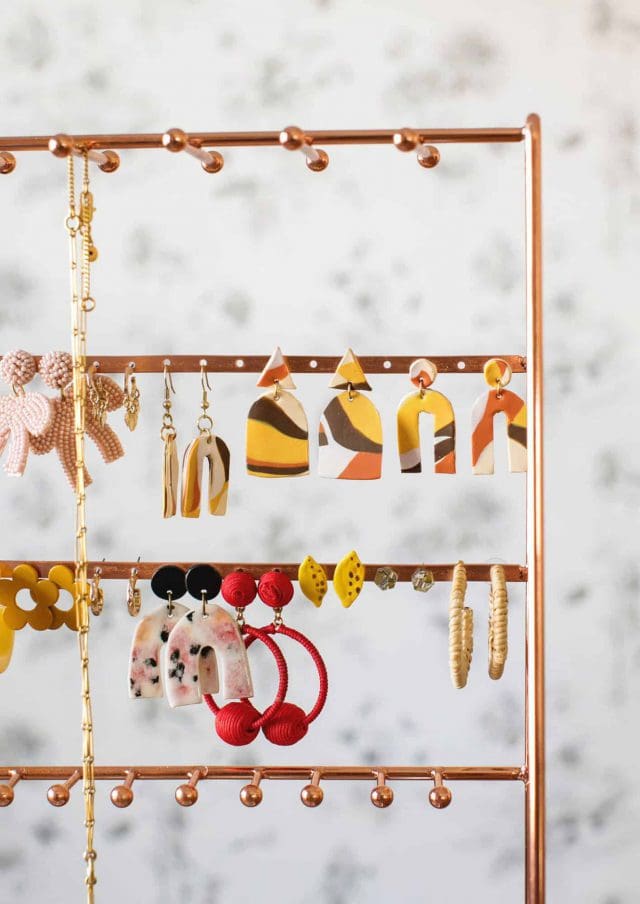
Friendship Bracelets
Most of us have made these as kids, so you know it can’t be that hard. Try a grown-up version that adults will actually buy and wear. Little Red Door has a Grown-up Friendship Bracelet tutorial.
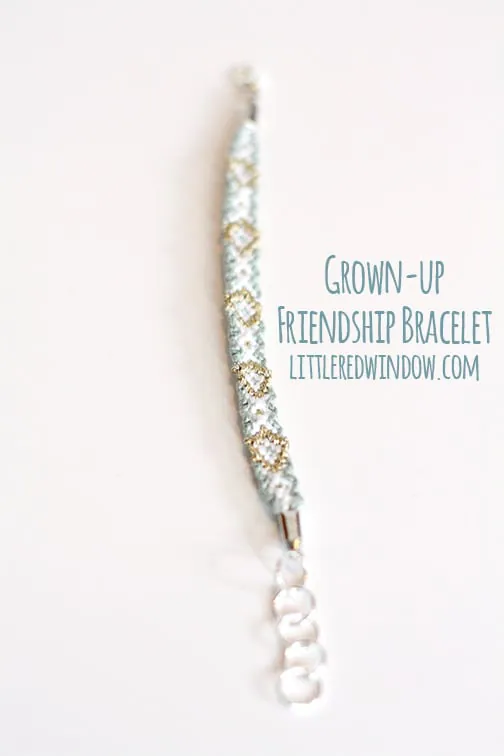
Wire Rings
Wire-wrapped jewelry is a good beginner project to dip your toes into jewelry making. Below is a simple tutorial to get you started. Rings are small and easy to start with, then you can apply a similar technique to bracelets and necklace pendants.
2 – Art
Everyone hangs some form of art in their home so it’s an industry people spend money on. The finer the art, the more money people are willing to spend.
Creating art is also one of those skills people inherently have. One can, of course, take art classes to refine their skills, but I find many artists are born with the ability to create art.
Art is also subjective, so if you find the right audience for your art, there are no rules for how much a piece of art should cost.
Material Costs
Art takes form in many mediums so material costs vary. A watercolor painting may only cost pennies in materials while a canvas for oil painting can cost over a hundred dollars. Sculptures may be made of recycled materials, keeping costs low, while supplies for glass art can add up.
An artist who paints or draws can also keep material costs low by creating one piece of original art and selling prints of it. The value of a print can still remain high if the artist has a unique style people are willing to pay for.
Digital art also has low material costs. You may create: Greeting cards, Invitations, Surface patterns which can be applied to stationery, wallpaper, fabrics, and more.
Labor Costs
The time required to create a piece of art depends on the artist and the piece of art they’re creating. The quicker an artist can pump out art, without compromising the quality, the higher the profits can be.
If the artist can create prints of their art and sell high volumes of those prints, it allows for profits through volume. They can’t charge as much for a print as they can for an original, but they may be able to sell more units of prints.
Overhead Costs
Basic business costs apply to an art business (e.g. craft show fees, Etsy fees, advertising costs, etc.), however, when it comes to drawings or paintings, the costs of tools can be kept low.
For digital art, there are typically fees for software (e.g. Adobe Illustrator).
And shipping costs may be slightly higher, depending on how large or fragile a piece of art is.
Easy Things to Make and Sell
It’s hard to fake it as an artist; you’re either an artist, or you’re not. As much as I love art and can paint, original art just doesn’t flow out of me. However, you can explore different medians and grow your skills as an artist. To see if creating art is the right fit for you, explore painting with acrylics or watercolor, or designing digital art online. Or you may want to explore more abstract art, like the tutorials below:
Resin Art
This is such a beautiful piece of art and Lily Adore has an extremely detailed tutorial on her blog, as well as on YouTube.

Weaving
Woven art and macrame are popular these days. If painting and drawing aren’t really your thing, explore this option. A Pretty Fix has 5 weaving tutorials.
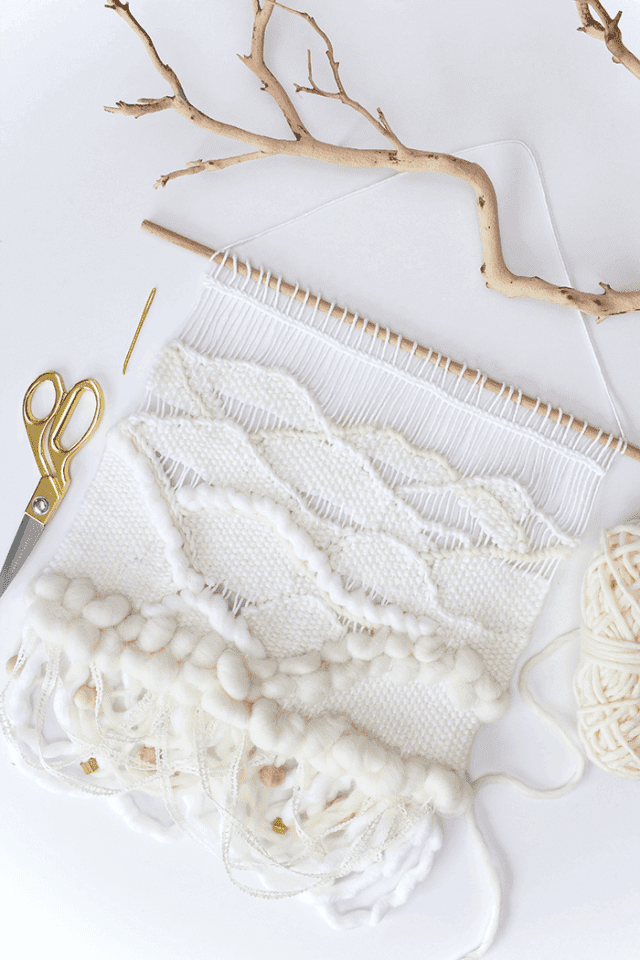
Fabric Art
Keep in mind, art that takes a long time to create can lower your profits (as mentioned below). If you’re able to create something like needlepoint art quickly and can charge a decent price, it may be a good craft to start selling.
Here’s a beginner punch needle tutorial by Lovely Indeed:
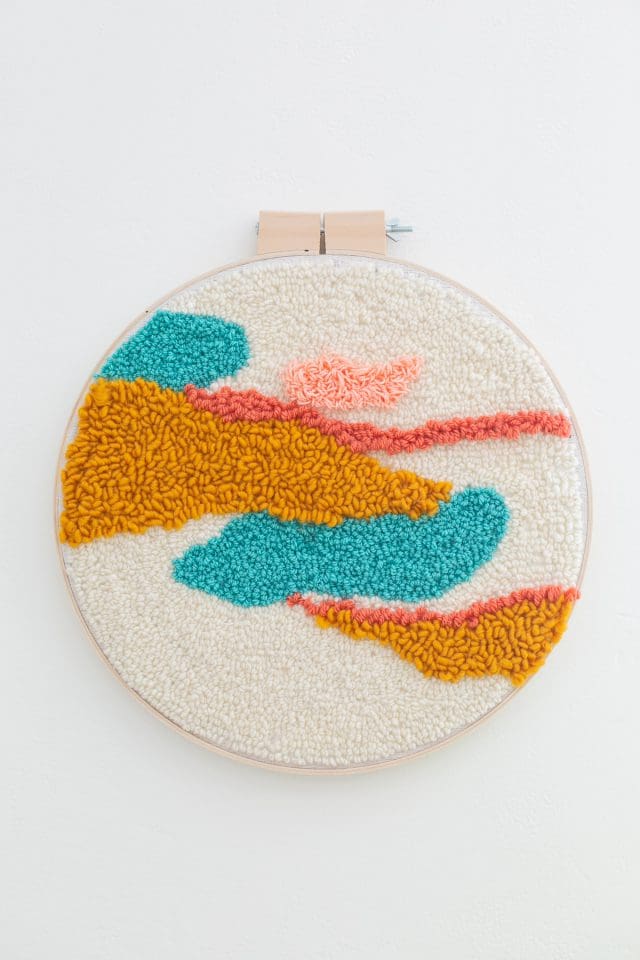
3 – Photography
Photography is similar to art in that some photographers can charge more for say, a photo of an apple, than other photographers. Their photography and editing style, which don’t necessarily have to increase costs, can increase the value of their work and the prices consumers are willing to pay.

Material Costs
Photographers have low material costs related to the printing of their photos and framing. If prints are sold digitally, there aren’t any material costs.
Labor Costs
Time spent on business tasks such as marketing and selling will be similar to what other craft businesses spend on those tasks.
Although material costs are low for photography, labor costs can go up with setting up to photograph, photographing, uploading, and editing photos.
Overhead Costs
On top of typical overhead costs (advertising fees, listing fees, website fees, etc.), the startup costs for a photography business can add up. Some of those may be: camera, lenses, travel cases, lighting, backdrops, darkroom & development (space, chemicals, tools, etc.)
Editing software and digital file storage may also be overhead costs for photographers.
4 – Soap & Candles
When you look at how much consumers typically pay for a bar of soap, selling handmade soap can seem like an unprofitable category. But handmade is not about selling an average product.

People are willing to pay more for products that are different or better. A business must simply know which features a market is willing to pay more for and offer them.
A consumer who buys a 20 pack of Irish Spring for $25 will never be your customer. So there’s no sense competing with businesses that sell $2 – $5 bars of soap.
A soap business (or bath & body business) can absolutely have high profit margins. But it likely must charge more than $5/bar of soap for those profits. And to charge more, it must be justified.
>> Maybe your soap has a high-end, hard to find ingredient for the skin-care junkie (*Remember, you can’t make medical claims about your soap, they must be cosmetic, more on that here.)
>> Or maybe your bar of soap is designed to clean body and hair, making it perfect for people who workout and shower at the gym, or for travelers who don’t want to pack light.
>> Or maybe your soaps have a healing crystal in them so they appeal to people into alternative healing or aligning chakras.
Start with a profitable target market then create a soap/bath & body product that appeals to them.
If you want to learn how to find a profitable target market for your handmade business, check out HOW TO FIND A GOLDMINE OF CUSTOMERS.
Material Costs
When time is taken to source ingredients and find the best price, and those ingredients are purchased in bulk, material costs for a bar of soap can be kept under $1.
Soap should always have some form of packaging, so that also factors into material costs. But again, proper sourcing and buying in bulk can lower the cost of soap sleeves or boxes.
Labor Costs
The process of soap making is usually completed in batches. Ingredients are measured, melted, and poured, to produce a slab that can be cut into several bars of soap. This assembly line process cuts down labor time (and is something every business should adopt).
A soap business will have the typical marketing and selling tasks to spend money on.
Overhead Costs
Typical business overhead expenses will apply. Areas that can increase these costs for a soap business are having a proper setup for soap making and following proper labeling. A soap business must understand label laws and take the time to properly apply them.
Soap businesses may also want liability insurance to protect the business. In the case a customer develops a rash from one of your products, product liability insurance gives you protection. (Personal assets can be in danger if a business isn’t set up properly. Check out LAWS FOR SELLING HANDMADE).
Soap Crafts to Make and Sell
Soap making does take some time to master, but it’s still fairly easy when you’re starting out. Consider choosing a niche target market if you’re going into the soap-making business. Because it’s an easy craft to make, there are lots of people selling soap on Etsy and at craft shows, which can make it hard for a new business to stand out and make sales.
Use How to Find a Goldmine of Customers to uncover a profitable target market and then create niche products for them.
For example, a profitable target market might be women who practice yoga. I could create a line of yoga-themed soaps made with natural ingredients or perhaps infused with something yoga-related (e.g. healing crystal-infused soap). Or I may package and label my soaps following a yoga theme or related to yoga (e.g. Root Chakra soap or soaps named after yoga poses). My soaps could be in shapes that are related to yoga (e.g. lotus-shaped soap).
The task of finding a profitable target market (I’ll show you how in this guide) and creating products for that target market makes it so much easier to stand out in a marketplace like Etsy, get stores to carry your products (e.g. I could contact yoga studios about carrying my soaps), and sell your products (consumers can find regular soap anywhere, but they would have limited options if they want yoga-themed soap).
Soap
Happiness is Homemade has lots of soap tutorials on their blog to explore.
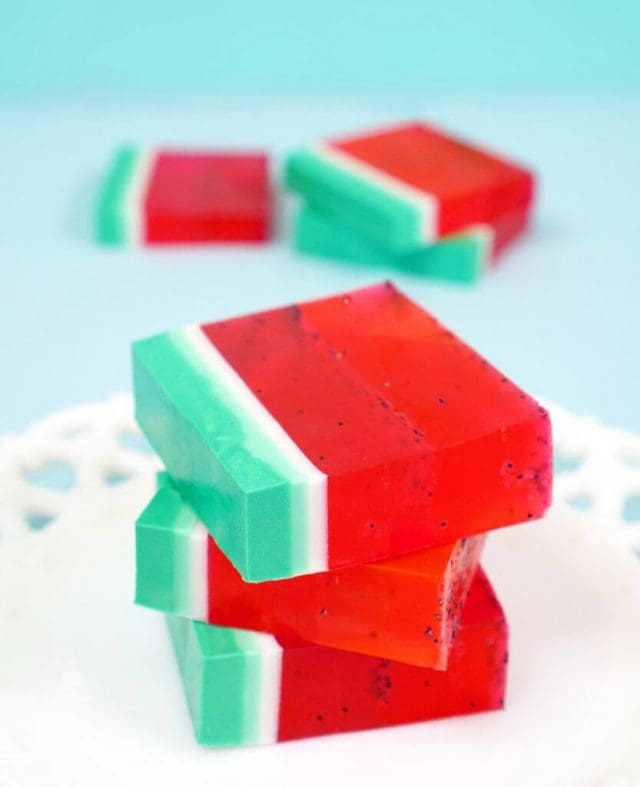
Bath Bombs
Here’s an easy tutorial on making bath bombs by A Pumpkin and a Princess:

Beauty Products
Once you’ve mastered basic soap making, you may want to move into beauty products such as nail polish, creams, lotions, scrubs, sprays, etc.
Keep in mind, you want to be sure you’re following the laws and labelling your cosmetics properly. Here are the regulations you must follow.
Here’s a glow serum by Happy Home Happy Heart to get you inspired:

Crafts that Typically have LOW Profits
These crafts can absolutely be profitable. The key, as with any business, is creating a product, brand, and business that targets a profitable target market so you can raise your prices and they seem justified to consumers.
If you want to learn how to find a profitable target market for your handmade business, check out HOW TO FIND A GOLDMINE OF CUSTOMERS.
Due to the amount of labor and/or overhead costs, the following crafts tend to be more difficult to achieve high profit margins.
Children’s Products
Although the industry of pregnancy/baby-related products is a popular one, products made for babies/children can be less profitable. Children’s products don’t necessarily have high costs, however, they have safety and label rules they must follow. If your business requires any safety testing or certificates, not to mention, insurance, costs can get high.
The easier / safer route if you want to sell under the profitable industry of pregnancy / babies is to create products for mom/dad.
Quilting
Because of the number of pieces that must be cut and sewn together, quilts are typically high in labor costs. People who appreciate quilt work are usually people who make them; and if someone can make a quilt, they likely will, rather than pay someone else to.
Consumers are accustomed to quilts sold in stores like Bed Bath & Beyond, which are mass-produced and may only be $50. This means the average consumer may not be aware of why a handmade quilt is so much more expensive and why they should buy one over what can be purchased for less in a big chain store.
If you are going to venture into quilt making, be sure you’re pricing your quilts properly with this article on the RIGHT quilt pricing formula. You may also be interested in how to create a successful quilt business.
Woodwork
Woodworking is a skill that takes time to develop, which means startup costs can be high. If consumers are paying more to purchase a handmade jewelry box, chair, or dresser, they’re expecting a high-quality item. That level of quality requires time to precisely cut each piece, sand, and finish an item.
Woodworking also tends to attract customers who want custom pieces. Creating new plans and making adjustments for each customer can eat into profits.
Beadwork
Beadwork is the art of attaching beads to each other, or to a surface, one at a time. This makes it time-consuming. There are machines that can produce beadwork much faster, making it harder to justify hand-beaded prices to consumers.
Needlework
Knitting and crocheting fall under needlework, as does embroidery. These types of crafts can be labor intensive and production can only move so fast without the help of machinery. Which makes needlework crafts less profitable.
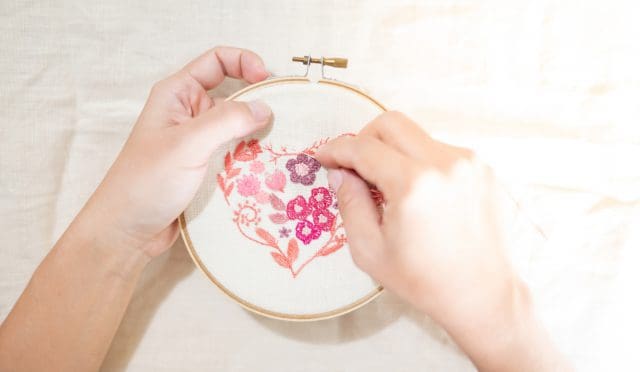
What are the most profitable markets?
For a craft business to be profitable, it must target a market that spends money on the products they’re selling
Some markets are more profitable than others.
For example, “moms with 5 or more kids” could be defined as a target market. However, those moms are likely focused on getting the most bang for their buck, saving money for their kids’ college funds, getting the kids to school on time, and keep track of everyone’s activities.
If I created a line of luxury bath & body products for that busy mom, I may not have a profitable business.
A mom of 5 kids likely:
>> doesn’t have time to browse social media, where she might discover my Facebook post marketing my bath products.
>> rolls her eyes and thinks “Wouldn’t that be nice!” when I describe relaxing bath time without the kids banging on the door.
>> thinks spending $60 on a face cream is ridiculous when that could buy enough diapers for a month.
A business selling products the mom to 5 kids needs (e.g. jumbo packs diapers) or products that would help her save money (e.g. reusable diapers), or that would make her life easier in some way, would be a better and more profitable fit.
You must target the right market and know what those consumers care about and are willing to spend money on.
You can’t go too broad with your target market or you’ll be competing with too many businesses and will have a hard time reaching and connecting with potential customers.
And you can’t go too narrow or it’ll be hard to find customers, and enough of them, to support your business.
HOW TO FIND A GOLDMINE OF CUSTOMERS will help you find the perfect, profitable target market for your craft business.
What crafts are trending this year?
For a craft to be profitable, it must have demand. Aside from targeting a profitable target market, you can also offer a product that’s trending.
What’s trending changes from year to year but you can check out this year’s hottest craft trends here:
What are the most profitable crafts to sell online?
Crafts that sell well online are crafts that are:
- Specific – people don’t head online and shop for “soap”. They look for something more specific (e.g. “charcoal facial soap”).
- Easy to ship – consumers don’t like paying high shipping fees or waiting weeks to receive their products.
- Unique – it’s much more competitive to sell online, so you must sell crafts that stand out and are different than your competitors.
If you plan to sell products online, you must consider two other elements:
1 – Shipping Costs
2 – Online shopping behavior
SHIPPING COSTS
Shipping costs can easily throw off a sale. I’ve abandoned several online carts because I got to the checkout and saw that either:
- The business didn’t have the option for me to select my country
- The cost of shipping was almost as much as the product
Understand where people visit your online shop from (Google Analytics provides this information) and what the costs are to ship your product to different states/provinces or countries.
The more countries you ship to, the more opportunities you have to sell your crafts online. But that also comes with more responsibility.
Keep in mind, when you sell products outside your jurisdiction, you must follow the laws of the destination you’re shipping to as well. More on that in LAWS FOR SELLING HANDMADE.
When profits are high, you can absorb some of the shipping costs and still be left with profits.
You can work part of the shipping fees into the price of the products. For example, let’s say it costs me about $5 to ship my items within my city. I could raise the price of my product by $5 and offer “free” shipping within my city.
If it costs $10 to ship my product to another province, I would charge just $5 to those customers, because the other $5 is worked into my product price.
Although the customer is paying the same amount, psychologically, they feel they’re getting a better deal. Paying more for the product, rather than shipping, feels like you’re getting more value for your money.
ONLINE SHOPPING BEHAVIOR
You must consider what people buy online and are willing to pay shipping fees for. Would you buy a bar of soap and pay $5 for shipping when you could easily grab a bar of soap from the grocery store or stop by a local craft show and skip the shipping fees?
Probably not.
There are people who purchase products online to skip the hassle of driving to the store. However, the majority of people tend to shop online when they’re looking for a hard-to-find item or something specific.
For example, if I’m looking for a yellow sundress with ruffle sleeves; I’d rather type that search term into Google and see hundreds of results than go to the mall and check hundreds of stores.
In this case, you must know which keywords shoppers are typing into searches so your listing or website is likely to come up.
For example, I buy handmade bars of soap at my local farmers’ market and craft shows in my city. I wouldn’t shop for a bar of soap on Etsy.
I might, however,
>> Look on Etsy if I was planning a wedding and wanted to give soap as a wedding favor. I might search “soap wedding favors”.
>> Or if I had just read in New Beauty magazine how amazing turmeric is for the skin and wanted to find a bar of soap infused with turmeric, I might enter the keywords I read in the magazine.
>> Or if I was shopping for someone’s birthday and wanted to find a novelty bar of soap or one that suited the recipient’s interests, I may search “zero waste soap” or “vegan soap” to find a gift for my earth-friendly pal.
People will buy almost any type of product online…and sometimes the weirder, more outlandish, the better.
But in most cases, people don’t head online to find products they can conveniently purchase in-person.
Consider what makes your product hard to find, out of the ordinary, or search-worthy to help determine if it will be a profitable product to sell online.
WHERE TO SELL CRAFTS ONLINE
The most common platforms for handmade businesses to sell handmade online are Etsy and building a website.
There are several other options for selling online, I’ve listed many here:
What makes a craft profitable to sell wholesale?
Selling your crafts wholesale to retailers means lower profits, but you’re selling them in higher volumes.
To sell wholesale, your products must have high profit margins.
>> Here’s the right pricing formula to follow
On average, most retailers expect to buy products wholesale at 50% of the retail cost.
If I’m selling a handbag for $100, the retailer would likely expect to purchase it from me for $50. They would then mark it up and sell it to their customers for $100. They need that $50 to cover their store’s expenses and to have profit leftover.
When selling wholesale, your sales costs (and sometimes marketing costs) can be lower.
You must still spend time and money marketing to retailers (e.g. setting up at tradeshows or craft shows (HOW TO ATTRACT WHOLESALE ORDERS AT CRAFT SHOWS), creating lookbooks (HOW TO CREATE A LOOKBOOK), etc.), however, when you make a sale, your units per transaction are much higher, and your cost of acquisition can be lower.
When a craft show shopper buys from me, they’re likely only buying one bag (and maybe an add-on product, check out: HOW TO USE ADD-ONS TO SELL MORE HANDMADE).
When a retailer buys from me, they might buy 10 bags (more units per transaction).
Let’s say I sell one of my bags for $100 and it costs me $30 in material and labor to make. I may require another $10 from that sale to help cover the cost of the craft show I sold it at, the time I spent marketing on Facebook that month, the cost to repair my sewing machine, etc. $60 is leftover for profit.
If I sell that bag to a retailer, I’m receiving $50 for it.
My profits are now only $10 from a sale of that bag. But the shop owner is likely to purchase more than one bag. I can even set a minimum order so that retailers must purchase 10 or more units to receive wholesale pricing. Then I’m guaranteed to profit $100 or more with one wholesale order.
SHIPPING
If you sell to retail shops within your city, you can drop orders off. However, I’ve found, you can quickly run out of retailers to carry your products within a city.
A retailer downtown doesn’t want to carry the same products as the retailer a couple of blocks away. Depending on the size of your city, that can limit how many stores you can sell to.
When you start shipping orders to retailers outside your city, you need to make sure the shipping costs aren’t too high.
Retailers should be paying those shipping costs, but again, they’re going to hesitate on placing an order if shipping is almost as expensive as their product order.
How can I make a craft more profitable?
To make a handmade product more profitable, it’s simply a matter of lowering the costs to produce, market, and sell a product, and/or raising prices. To raise prices without raising eyebrows, the perceived value of a product must also increase.
The exact elements that must change to lower costs and/or increase prices and perceived value depend on the business and the market it targets. Only you know how much materials cost, how much time you spent making an item (and the hourly wage you’re paying yourself), as well as your overhead costs.
Soap can be a profitable product to make and sell, however, it’s made less profitable if the business owner:
>> hasn’t streamlined their process and takes too long to make a batch of soap, cut it into bars, and package it.
>> is renting a space for production.
>> pays high fees for craft shows and doesn’t have a display or sales pitch that produces enough sales to cover craft show fees and then some.
>> doesn’t give shoppers a valid reason for consumers to pay higher prices for their bar of soap instead of buying a bar of Irish Spring.
A product alone won’t ensure a craft business is profitable; your entire business must be set up to profit.
The basic formula to increase profits is to:
>> Decrease costs (less money going out)
>> Increase prices (more money coming in)
*For loads of simple tips on how to make your handmade business more profitable, check out THE SUCCESS PLANNER
Selling a typically profitable product (e.g. jewelry) to a typically profitable industry (e.g. wedding) doesn’t guarantee you’ll have a profitable craft business.
So let’s look at a few ways you can increase your profits and probability of building a profitable craft business.
What decreases profits?
Costs are what decrease products: material costs, labor costs, and overhead costs. Here’s a brief description of the costs a business must be aware of, which can eat into profits:
MATERIAL COSTS
These are the costs of any materials required to create a “sale ready” product.
Let’s say I’m selling handmade purses, my material costs might be:
- Outer fabric
- Lining fabric
- Zipper
- Thread
- Hardware (e.g. metal rings to attach or adjust straps)
- Brand tag sewn into the lining
- Price tag & ribbon to attach it
If I wrap each purse in tissue paper, secured the tissue paper with a sticker, and place the purse inside a branded box, those would also be material costs.
LABOR COSTS
Your labor costs will be ANY hours you spend working on your business, multiplied by your hourly wage.
You get to set your hourly wage, but don’t cheap out!
If you build your business and prices on not paying yourself an hourly wage, or a low wage, you’re setting your business up for failure. Not paying yourself is not sustainable.
Imagine you’re working for another business. You head into work and they ask you to drive to the post office to send a package. When you get back, they let you know you won’t be paid for the hour it took you to drive there, stand in line, pay, and drive back. Not only did you have to put miles on your car and burn your gas, now you’re not being paid for your time.
That would never fly. Yet so many handmade business owners treat themselves that way and aren’t being paid for their time.
Track the time spent on your business, pay yourself a reasonable wage for those hours, and check to be sure you still have profits after covering all costs and wages.
For my purse business, my hours may be spent:
- Sewing purses
- Steaming, lint rolling, and attaching price tags
- Applying to craft shows
- Packaging stock for craft shows
- Setting up, selling, and packing up at craft shows
- Taking photos of products
- Uploading & editing photos
- Updating my Etsy shop
- Posting to Facebook
- Planning my year with THE SUCCESS PLANNER 🙂
- Recording & tracking sales & making a plan to increase them next month (also using THE SUCCESS PLANNER)
- Packaging online orders
- Updating order status
- Mailing orders
- Ordering more shipping supplies
- Etc.
There are many more tasks that may require your time.
There are tasks that are consistently done (e.g. posting to Facebook each day or updating an Etsy shop every week) and those that are less consistent (e.g. taking a sewing machine in to get repaired).
The time spent on each business task must be accounted for so you can be paid for them. Your wage will reduce profits.
OVERHEAD COSTS
Overhead costs are any expenses that aren’t directly related to the production of your products.
Some of the overhead costs my purse business may have are:
- Tools – Pins, seam ripper, sewing machine, serger, etc.
- Listing fees
- Commission and transaction fees
- Craft show fees
- Website hosting fees
- Advertising fees (e.g. placing an Etsy or Facebook ad)
- Cost to repair sewing machine or sharpen scissors
- Training (e.g. I may take a sewing class to improve my skills)
- Shipping supplies
- Packaging supplies (e.g. shopping bags for craft shows)
- Marketing material (e.g. business cards, postcards, etc.)
- Etc.
Ways to make your craft business more profitable
Think about all the tasks you spend time on for your business and anything you spend money on.
I find it helps to look at a business in 3 areas: creating, marketing, and selling. Think about everything you spend time and money on when it comes to:
- making products
- marketing those products
- selling products
Also, consider admin tasks that require your time and money. For example, legal tasks such as registering your business, filing taxes, etc. (check out LAWS FOR SELLING HANDMADE for more), answering emails, tracking inventory, etc.
Find more information on making your business more profitable in THE SUCCESS PLANNER.
Once you know all of your expenses, consider the following ways to reduce them.
BUY IN BULK
Take the time to source your materials and find the best bang for your buck. Even if you can’t find a discount for buying them in bulk, you’ll save on shipping costs by grouping items together.
Your business may or may not need a business license (find out if yours does) but having one can give you access to wholesale pricing from some suppliers.
CREATE IN BATCHES
Grouping work tasks together can reduce the time spent on them, as well as reduce time wasted by constantly switching between tasks.
Think about all areas of your business:
- CREATING
- MARKETING
- SELLING
- ADMIN
How can you group tasks together to reduce the time they take?
For example, when creating bags, I may cut all my pattern pieces one day, serge all seams the next, sew pieces together another day, install all zippers another day, etc. I get in the groove of a task, which allows me to complete it faster, and I’m not switching between stations, machines, threads, etc.
I may spend a day photographing all bags from my newest collection, then upload and edit them another day so I’m not having to set up my lightbox or backdrop, wait for the right lighting, or open my editing software program multiple times.
I may also group writing product descriptions together and whip up multiple descriptions on one day (the day I don’t have writer’s block), which then can be quickly copied and pasted on the day I add new listings to my Etsy shop.
PAY ATTENTION TO ROI
ROI stands for return on investment. It calculates how much money you spent on a task (your time/wage included) and how much money that specific task generated. If you’re spending 5 hours a week on Facebook, you want that work to be generating sales. If you don’t track how many hours you spent and how many sales are from people who saw your Facebook posts, there’s no way to know if your Facebook efforts are paying off.
When you calculate the ROI of tasks, you can then use your time and money more effectively.
If you discovered those 20 hours spent on Facebook each month only made you one $20 sale, would you continue putting 20 hours/month in
Probably not. That time can be better spent on a task that generates more sales and gives you a return on investment.
More on tracking, calculating, and improving ROI in THE SUCCESS PLANNER
REDUCE OVERHEAD COSTS
When you’re not aware of the overhead expenses your business has, it’s easy for them to eat into your profits.
Start tracking overhead costs and determine what’s necessary and what can go.
INCREASE PERCEIVED VALUE
The elements that surround your products can make shoppers believe they’re more valuable.
Which is why you expect a t-shirt to cost around $10 when you’re in an Old Navy, and over $100 when you’re in a Versace store. The quality of a Versace t-shirt is better, but the quality isn’t 10x better than Old Navy’s. People are paying for the perceived value.
Simply improving your branding, product packaging, craft show display, website, photos, etc. can lead shoppers to place a higher value on your products, which allows you to charge more.
What can I make at home and sell for money?
The beauty of starting a craft business is that most items can be made at home. They don’t require big studios or expensive equipment to get started.
Determining what to sell isn’t nearly as important as determining who to sell to.
You must start with a profitable target market; a group of people who are guaranteed to be interested in what you’re selling (based on their interests) and almost guaranteed to buy your products.
The craft industry is too competitive to simply start making jewelry, or soap, or pottery, or knitted goods, etc. If you don’t have a unique angle that appeals to a specific group of people, your items will simply get lost in the crowd on Etsy.
Start by determining your profitable target market (HOW TO FIND A GOLDMINE OF CUSTOMERS will help you do just that).
Then explore the different types of products you can sell to that profitable target market.
Here are 100+ CRAFTS YOU CAN MAKE & SELL FROM HOME
Take the time now to add up all your business expenses and calculate your profit margins. If they’re low, work on ways to improve them.
LINKS MENTIONED IN ARTICLE:
- THE SUCCESS PLANNER
- LAWS FOR SELLING HANDMADE
- 3 MISTAKES HANDMADE BUSINESSES MAKE WITH THEIR USP
- LAWS FOR SELLING HANDMADE SOAP & COSMETICS
- CRAFT TRENDS FOR THIS YEAR
- WHERE TO SELL HANDMADE ONLINE (BESIDES ETSY)
- HOW TO ATTRACT WHOLESALE ORDERS AT CRAFT SHOWS
- HOW TO CREATE A LOOKBOOK
- HOW TO FIND A GOLDMINE OF CUSTOMERS

Hey, I’m Erin 🙂 I write about small business and craft show techniques I’ve learned from being a small business owner for almost 2 decades, selling at dozens of craft shows, and earning a diploma in Visual Communication Design. I hope you find my advice helpful!

Thanks for your recommendations. I have a big experience in creation of flowers and costume jewelry from cold porcelain because it is a very unusual gifts – check my works here https://www.instagram.com/cold_porcelain_flowers/ . Please, use my photos to show your readers new ideas of crafting.
I have had a lifelong love of dachshunds (wiener dogs) and I am not alone. I have met many, many people who share the same passion and we are always on the look-out for anything with dachshunds on it! It is hard to find dachshund-specific products in a sea of items at pet shops, home decor stores, and other retailers. This led me to start Wiener Dog Wares, a business dedicated solely to dachshund themed products. WDW carries apparel and accessories, artwork, home decor, kitchen wares, jewelry, dachshund apparel, and the list goes on.
I have sold for years at craft shows and was never satisified with the look of my booth. Reading your display ideas and thinking more in terms of a retail look has me ordering products to make it look cohesive and professional. My first show is less than a month away and I’m excited to implement your ideas and suggestions. I’ll be sending before and after photos of the results.
Thank you for your willingness to share your knowledge with fellow crafters. I am less than three years to retirement and my goal is to have WDW replace my working income. (An actual retail store is in the plans!)
Hail to the Dachshund! Because everyone knows, they expect it!